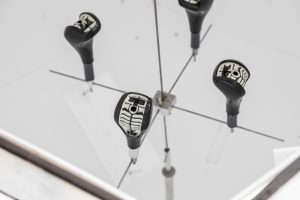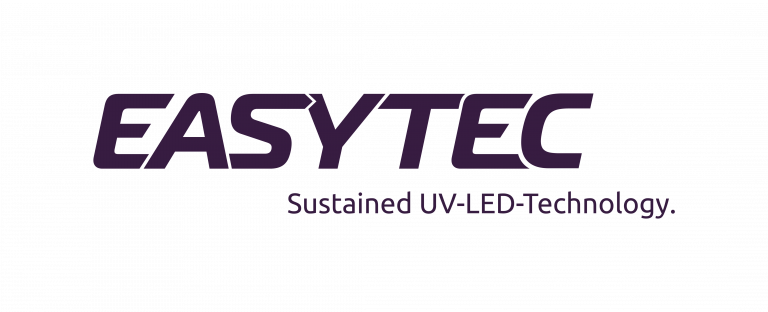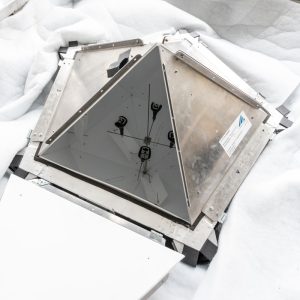UV-LED Pulse Ball – The Future of Surface Curing for 3D Parts
Additive manufacturing, commonly known as 3D printing, has rapidly advanced in recent years and has become a key technology in various industries. From prototype development to mass production, 3D printing has demonstrated its versatility and efficiency. Despite these successes, challenges remain in the surface finishing of printed parts. This is where EASYTEC’s UV-LED Pulse ball technology comes in, offering an innovative method for surface hardening of UV coatings on 3D parts.
What is a UV-LED Pulse Ball?
A UV-LED Pulse ball is a device that uses ultraviolet light to cure the surface of 3D parts. Unlike traditional curing methods (e.g., thermal), which often require longer curing times and can cause possible deformations (e.g., in plastics), the UV-LED Pulse ball technology provides a fast, high-quality, and energy-efficient solution. The Pulse ball emits short, high-intensity UV-LED light pulses, activating the photoinitiators in the resin and enabling rapid surface hardening through polymerization.
Advantages of UV-LED Pulse Ball Technology
Fast Curing: Using short light pulses, the UV-LED Pulse ball cures the surface of parts in seconds, significantly reducing overall processing time. It also allows for the simultaneous curing of multiple workpieces in one operation.
Precision: The precise digital control of irradiation intensity and dose ensures uniform polymerization without over-curing or thermal deformation of the parts. The consistent irradiation and curing of complex components are further enhanced by the interior surfaces of the UV Pulse ball, which reflect UV radiation.
Energy Efficiency: Compared to traditional curing methods (e.g., dryers with mercury lamps or thermal nozzle dryers), UV-LEDs consume significantly less energy and have a much longer lifespan. Additionally, the multiple radiation reflections within the Pulse ball improve light efficiency. The better energy efficiency of LEDs also reduces the CO2 footprint, resulting in lower costs for CO2 emissions.
Environmental Friendliness: UV-LEDs contain no toxic materials (e.g., mercury) and produce no ozone, making them more environmentally friendly and safer. The significantly lower energy consumption further reduces the CO2 footprint, enhancing their environmental friendliness.
Versatility: The UV-LED Pulse ball technology is compatible with almost all solid materials (e.g., paper, cardboard, plastic, glass, wood, and metal) and can be used for a wide range of UV curing applications, from prototypes to series production, from small parts to large components.
Applications of UV-LED Pulse Ball Technology
UV-LED pulse ball technology creates a homogenous field, making it optimal for curing the surface of 3D models and products as the UV-LED rays reach different angles that are not easily reached by other curing methods. Thus the technology finds applications across various industries, including:
Printing Industry: UV-LED Pulse ball systems can be extensively used in the printing industry for curing UV-curable inks and coatings. The systems ensure fast and reliable curing on bottles, tubes, cans, pots, and other 3D substrates, whether printed with digital or screen printing.
Electronics Manufacturing: In electronics manufacturing, UV-LED curing systems are used to cure protective coatings, adhesives, potting compounds, and coatings used in assembling electronic components and devices. The homogeneous UV radiation field in the Pulse ball ensures curing even in otherwise hard-to-reach areas. The systems offer fast curing times and low heat generation, which is crucial for sensitive electronic components. They also provide excellent adhesion and chemical resistance, enhancing the reliability and durability of electronic products.
Wood Coating and Finishing: UV-LED curing systems are increasingly used in the wood coating and finishing industry to cure UV-curable primers and varnishes applied to wood surfaces. These systems enable fast curing of varnishes with little to no solvent content and without the need for high-energy air temperatures, significantly reducing energy consumption and emissions. UV-LED curing of varnishes also offers superior scratch/abrasion resistance and color brilliance, making them ideal for applications requiring durable and high-quality surfaces on wood products like furniture and flooring.
Medical Device Manufacturing: UV-LED curing systems play a crucial role in the manufacturing of medical devices, where precise and sterile conditions are paramount. These systems are used for bonding and sealing medical instruments, implants, and devices, as well as for curing surface coatings. UV-LED curing ensures rapid and consistent curing without the risk of thermal damage or contamination, meeting the stringent requirements of the medical industry. With advancements in UVC-LED systems, effective sterilization in medical and healthcare applications is now possible, ranging from air sterilization to device and surface decontamination.
Automotive Applications: UV-LED curing systems are used in the automotive industry to cure coatings, adhesives, and sealants in the manufacturing and assembly of vehicles and components. For instance, in electric mobility, battery cells are bonded with UV adhesives. These UV-LED systems offer benefits such as reduced cycle times, improved process efficiency, and enhanced performance properties of cured materials. UV-LED curing also enables the bonding of different materials in lightweight construction, contributing to fuel efficiency and sustainability in mobility.

Source: Fraunhofer Institute IAT
Conclusion
The UV-LED Pulse ball technology offers an efficient and precise solution for surface hardening of 3D parts. With its advantages in speed, precision, energy efficiency, and versatility, it is poised to become an indispensable part of additive manufacturing.
EASYTEC has already applied this technology in projects to harness the efficiency and precision of the UV-LED Pulse ball. By integrating UV-LED curing systems into production lines, EASYTEC has significantly reduced production cycle times, increased throughput rates, and improved production quality. Furthermore, EASYTEC’s commitment to sustainability is evident through its use of UV-LED technology, which minimizes energy consumption, eliminates the use of hazardous chemicals, and reduces the environmental footprint. Through continuous development and optimization of UV-LED technologies and Pulse ball techniques, EASYTEC can further enhance the production processes and product quality for manufacturers of 3D parts.

